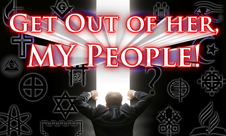|
The “sign of the prophet Jonah” encompasses far more than most people have realized. A careful study of Scripture reveals that the “three days and three nights” the Saviour spent in the “heart of the earth” began in Gethsemane, the night He was betrayed. |
Special Note:
As we embark on this study, bear in mind that some of the ‘confusion’ involved in this matter was somewhat intentional - in that Yahushua always spoke in PARABLES when the unbelieving ‘Jews’ were present.
Yahushua gave the unbelieving Jewish 'sign seekers' the sign of Jonah as a PARABLE which they would not understand, and many continue in confusion about it today.
He said "An evil and adulterous generation seeks after a sign, and no sign will be given to it except the sign of the prophet Jonah. For as Jonah was three days and three nights in the whale's belly, so shall the Son of man be three days and three nights in the heart of the earth" (Mt 12:40)
However, to his disciples he made it plain - PRIVATELY!
Then he took unto him the twelve, and said unto them, Behold, we go up to Jerusalem, and all things that are written by the prophets concerning the Son of man shall be accomplished. For he shall be delivered unto the Gentiles, and shall be mocked, and spitefully entreated, and spitted on: And they shall scourge him, and put him to death: and the third day he shall rise again. (Luke 18:31-33)
And they shall scourge him, and put him to death: and the third day he shall rise again.
The Old Testament predicted it:
After two days will he revive us: in the third day he will raise us up, and we shall live in his sight. (Hosea 6:2)
The New Testament confirmed it:
Paul pinpoints the actual timespan from the physical burial to His rise – he does not say 'before OR after' 3 days …..
"And that he was buried, and that he rose again the third day according to the Scriptures:... (I Corinthians 15:4)
 The children had been studying the story of Jonah for Bible Class. Mrs. Fredericks asked her second grade class to draw a picture about Jonah. Most of the children drew pictures of Jonah in the water with the fish or being swallowed. A few did a side angle showing Jonah praying inside the fish. When Mrs. Fredericks looked at Jennifer’s picture, though, she had no idea what it was supposed to be. Inside a large rectangle were three beds and three smiling suns above stick figures of a father and little boy holding hands. Most of the rectangle had been filled in with brown crayon. Across the top, was a fringe of green grass. Little roots below the grass had been meticulously drawn in. “Jennifer, you were supposed to draw a picture about Jonah but I don’t see him anywhere in your picture. Did you not understand the assignment?” “No, I did, Mrs. Fredericks! See? This is the sign of Jonah: the son of man is in the ground for three days and three nights. See the little boy? He’s the son. The beds are the three nights. The suns are the days and it’s all in the ground.” While the picture brought a chuckle to her teacher, most Christians aren’t any closer to understanding the “sign of Jonah” than little Jennifer. Different churches teach different interpretations of what the Saviour meant when He prophesied of His death, saying: “An evil and adulterous generation seeks after a sign, and no sign will be given to it except the sign of the prophet Jonah. For as Jonah was three days and three nights in the belly of the great fish, so will the Son of Man be three days and three nights in the heart of the earth.” (Matthew 12:39-40, NKJV)
The children had been studying the story of Jonah for Bible Class. Mrs. Fredericks asked her second grade class to draw a picture about Jonah. Most of the children drew pictures of Jonah in the water with the fish or being swallowed. A few did a side angle showing Jonah praying inside the fish. When Mrs. Fredericks looked at Jennifer’s picture, though, she had no idea what it was supposed to be. Inside a large rectangle were three beds and three smiling suns above stick figures of a father and little boy holding hands. Most of the rectangle had been filled in with brown crayon. Across the top, was a fringe of green grass. Little roots below the grass had been meticulously drawn in. “Jennifer, you were supposed to draw a picture about Jonah but I don’t see him anywhere in your picture. Did you not understand the assignment?” “No, I did, Mrs. Fredericks! See? This is the sign of Jonah: the son of man is in the ground for three days and three nights. See the little boy? He’s the son. The beds are the three nights. The suns are the days and it’s all in the ground.” While the picture brought a chuckle to her teacher, most Christians aren’t any closer to understanding the “sign of Jonah” than little Jennifer. Different churches teach different interpretations of what the Saviour meant when He prophesied of His death, saying: “An evil and adulterous generation seeks after a sign, and no sign will be given to it except the sign of the prophet Jonah. For as Jonah was three days and three nights in the belly of the great fish, so will the Son of Man be three days and three nights in the heart of the earth.” (Matthew 12:39-40, NKJV) - From the crucifixion Friday morning to the resurrection on Sunday morning.
- Wednesday night to Saturday night.
- Burial time in the grave only, i.e., Friday night to Sunday morning.
Crucifixion to resurrection: Many assume the sign of Jonah refers to the time period from the crucifixion until the resurrection. This is incorrect for the Saviour was crucified midmorning, at the time of the morning sacrifice on Abib 14. So while parts of three days are spanned, it accounts for only two nights.
Wednesday night to Saturday night: Other Christians believe that the sign of Jonah required Yahushua to spend a total of 72 hours in the sepulcher. Under this scenario, they teach the crucifixion occurred on Wednesday of the Julian calendar. This belief is also incorrect for it places the resurrection on Saturday night. This is incorrect for two reasons. First, as previously stated, the Julian calendar was not used by the Jews at the time of Yahushua. Secondly, Scripture is clear that the resurrection did not occur the night of Abib 15. Rather, it occurred at dawn on the morning of Abib 16: “In the end of the sabbath, as it began to dawn toward the first day of the week, came Mary Magdalene and the other Mary to see the sepulcher.” (Matthew 28:1)The crucifixion occurred in keeping with the great system of types and anti-types established by Yahuwah at the time of the Exodus. Therefore, it could not have occurred any time prior to Abib 14.
Friday night to Saturday night: Others have erred by assuming that only the hours Yahushua spent in the grave qualify as being “in the heart of the earth.”
Lazarus had just risen from death in a tomb after four days and the Pharisees who wanted a sign were very aware of it. Did [Yahushua] mean to repeat this miracle, for fewer days, and offer it as a sign? No, the sign was much more than rising from the dead after three days and nights in a tomb. The sign was to immerse Himself in our sins, separated from [Yahuwah] as Jonah prophesied, where [Yahuwah] would not hear, pay for our sins with suffering, death and on the third day rise again.1
To understand the sign Yahushua gave, it is necessary to understand the symbolic language He used. As always, Scripture provides the clues to explain its own mysteries. There are three points which, when understood, clearly reveal the meaning of Yahushua’s reference to the “sign of the prophet Jonah”:- Inclusive versus exclusive counting
- The meaning of the phrase, “heart of the earth”
- When the “three days and three nights” began
“The heart is deceitful above all things, And desperately wicked; Who can know it?” (Jeremiah 17:9)
“Then Yahuwah saw that the wickedness of man was great in the earth, and that every intent of the thoughts of his heart was only evil continually.” (Genesis 6:5)

Now all things are of Yahuwah, who has reconciled us to Himself through Yahushua the anointed, and has given us the ministry of reconciliation, that is, that Yahuwah was in Yahushua reconciling the world to Himself, not imputing their trespasses to them, and has committed to us the word of reconciliation…For He made Him who knew no sin to be sin for us, that we might become the righteousness of Yah in Him. (2 Corinthians 5:18-19, 21)
The entire fifty-third chapter of Isaiah explains this divine exchange:But He was wounded for our transgressions,
He was bruised for our iniquities;
The chastisement for our peace was upon Him,
And by His stripes we are healed…
Yahuwah has laid on Him the iniquity of us all.
And He was numbered with the transgressors,
And He bore the sin of many,
And made intercession for the transgressors.
(Isaiah 53:5-6, 12)
“But your iniquities have separated you from your Elohim;
And your sins have hidden His face from you,
So that He will not hear.”
(Isaiah 59:2)
“If I regard iniquity in my heart,
The Master will not hear.”
(Psalm 66:18)
In the Garden of Gethsemane Christ suffered in man’s stead, and the human nature of the Son of [Yahuwah] staggered under the terrible horror of the guilt of sin, until from His pale and quivering lips was forced the agonizing cry, “O my Father, if it be possible, let this cup pass from me:” but if there is no other way by which the salvation of fallen man may be accomplished, then “not as I will, but as thou wilt.” Human nature would then and there have died under the horror of the sense of sin, had not an angel from heaven strengthened Him to bear the agony.3
Yahushua was the Lamb of Yah that takes away the sins of the world. He was crucified on the Passover (Abib 14) so that the justice of Yahuwah would pass over repentant sinners, just as the Angel of Death passed over the Israelites in Egypt. However, His suffering began in the Garden of Gethsemane, after the Last Supper, on the evening of Abib 13.The power that inflicted retributive justice upon man’s substitute and surety, was the power that sustained and upheld the suffering One under the tremendous weight of wrath that would have fallen upon a sinful world. Christ was suffering the death that was pronounced upon the transgressors of [Yahuwah’s] law.
It is a fearful thing for the unrepenting sinner to fall into the hands of the living [Eloah]. … But never was this proved to so great an extent as in the agony of Christ, the Son of the infinite [Eloah], when He bore the wrath of [Yahuwah] for a sinful world. It was in consequence of sin, the transgression of [Yahuwah’s] law, that the Garden of Gethsemane has become pre-eminently the place of suffering to a sinful world. No sorrow, no agony, can measure with that which was endured by the Son of [Yahuwah].4

“From that time Yahushua began to show to His disciples that He must go to Jerusalem, and suffer many things from the elders and chief priests and scribes, and be killed, and be raised the third day.” (Matthew 16:21)
The third day from when? From when the suffering began. Read on:“And He opened their understanding, that they might comprehend the Scriptures. Then He said to them, ‘Thus it is written, and thus it was necessary for the Christ to suffer and to rise from the dead the third day.’ ” (Luke 24:45-46)
“And He began to teach them that the Son of Man must suffer many things, and be rejected by the elders and chief priests and scribes, and be killed, and after three days rise again.” (Mark 8:31)
This text is of particular note because it is very clear that the rising again comes after a three-day process that began with His suffering. Luke 24 records the story of two men walking from Jerusalem to their home in Emmaus on Abib 16, the day of the resurrection. As they walked, they discussed “all these things which had happened.” (Luke 24:14)So it was, while they conversed and reasoned, that Yahushua Himself drew near and went with them. But their eyes were restrained, so that they did not know Him.
And He said to them, “What kind of conversation is this that you have with one another as you walk and are sad?”
So they said to Him, “The things concerning Yahushua of Nazareth, who was a Prophet mighty in deed and word before Eloah and all the people, and how the chief priests and our rulers delivered Him to be condemned to death, and crucified Him. But we were hoping that it was He who was going to redeem Israel. Indeed, besides all this, today is the third day since these things happened. (Luke 24:15-17, 19-21)
This gave the Saviour the opening He wanted to teach them and inspire their faith:Then He said to them, “O foolish ones, and slow of heart to believe in all that the prophets have spoken! Ought not the Christ to have suffered these things and to enter into His glory?” And beginning at Moses and all the Prophets, He expounded to them in all the Scriptures the things concerning Himself. (Luke 24:25-27)
(To read the other Scripture passages showing this same process of events, click here and scroll down.5) It is not necessary to ignore this wonderful prophecy of the Saviour’s sufferings and death, nor is it necessary to impose a full 72 hours on the time period. The time period from the evening of Abib 13 until dawn6 on Abib 16 meets the parameters of this prophecy. The “sign of the prophet Jonah” was perfectly fulfilled in the Saviour’s sufferings and death when He voluntarily accepted the condemnation of the law against sinners and submitted to being separated from Yahuwah for the sake of redeeming mankind.






